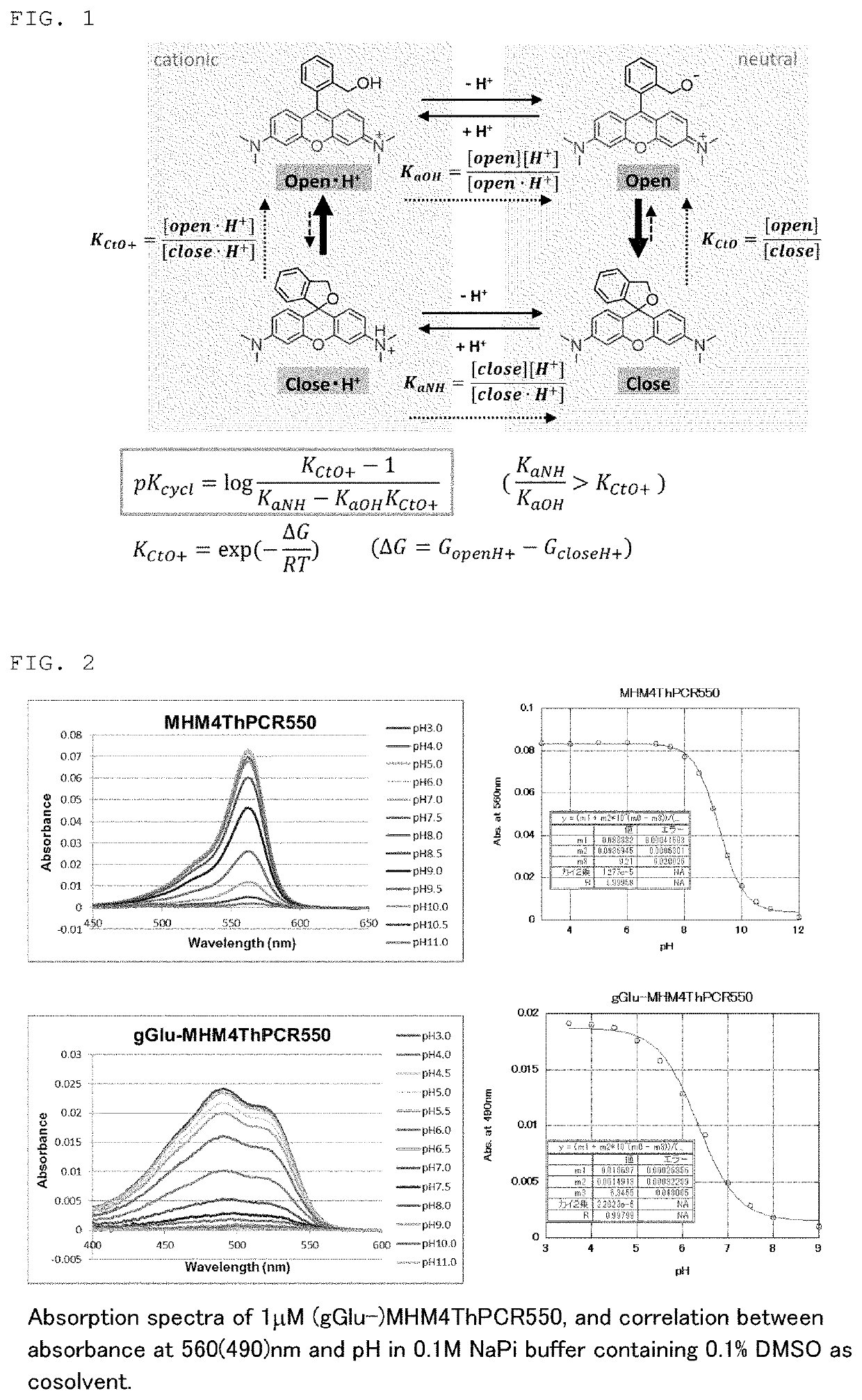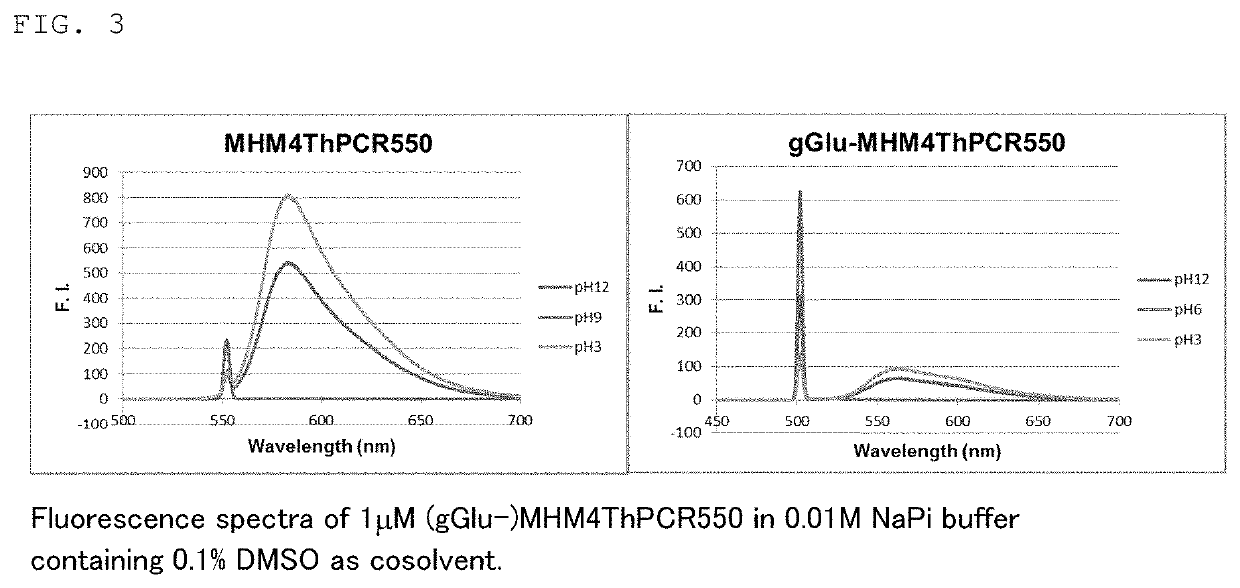Red fluorescent probe for use in detection of peptidase activity
a fluorescent probe and activity technology, applied in the field of fluorescent probes for detection of peptidase activity, can solve the problems of difficult complete removal, inability to apply probes to cancer cells present in living tissues or within organs such as lymph node metastases, and achieve the effect of accurately visualizing and detecting cancer cells and the lik
- Summary
- Abstract
- Description
- Claims
- Application Information
AI Technical Summary
Benefits of technology
Problems solved by technology
Method used
Image
Examples
example 1
1. Synthesis of Fluorescent Probe
[0086]1-1. Synthesis of gGlu-MHM4ThPCR550
[0087]A fluorescent probe 1 (gGlu-MHM4ThPCR550) having the following structure which is a compound of formula (I) of the present invention was synthesized.
[0088]gGlu-MHM4ThPCR550 (compound 16) was synthesized according to the synthesis scheme shown below.
[Synthesis of Compound 4]
[0089]Compound 4 was synthesized according to the literature (O'Sullivan, S., Doni, E., Tuttle, T. and Murphy, J. A., Angew. Chem., 2014, 53, 474-478).
[Synthesis of Compound 5]
[0090]Vilsmeier reagent (7.4 g, 57.7 mmol) was dissolved in anhydrous DMF (40 mL), and the mixture was stirred in an Ar atmosphere at 0° C. Next, compound 4 (10.0 g, 10.9 mL, 57.7 mmol) was added, and stirring was continued for 20 hours at room temperature. Saturated NaHCO3 was added to terminate the reaction, and the mixture was extracted using CH2Cl2. The organic solution was dried using Na2SO4, filtered, and evaporated. The residue was purified by flash column...
example 2
[0146]2. Study of Red Probe Structure Based on pKcycl Calculation
[0147]The structure of suitable fluorescent probe compounds capable of exhibiting fluorescence by cleavage of an acyl residue of formula (I) by a peptidase which is the target was studied based on the calculated pKcycl values.
[0148]As shown in FIG. 1, an equilibrium / kinetic model consisting of only four molecular species, in consideration of protonation of amino groups and deprotonation of hydroxymethyl groups (HM), was devised as a model of intramolecular equilibrium of compounds having a rhodamine skeleton. A formula that calculates pKcycl from the free energy difference of the closed-ring form / ring-opened form by the analyzed cationic reaction was derived, assuming that acid-base equilibrium (lateral direction in the model) is reached quickly enough in the HM groups and amino groups. When the calculation results of close-1, open-1 were used as this free energy difference, it was understood that pKcycl of existing de...
example 3
3. Absorption / Fluorescence Spectrum Measurement of the Fluorescent Probe of the Present Invention
[0150]The absorption spectra and fluorescence spectra of fluorescent probe 1 (gGlu-MHM4ThPCR550) and fluorescent probe 2 (gGlu-HM3ThPSiR600) synthesized in Example 1 were each measured.
[0151]FIGS. 2 and 3 respectively show the absorption spectra and fluorescence spectra of fluorescent probe 1 (gGlu-MHM4ThPCR550) and, as a comparison, MHM4ThPCR550 having no gGlu group. The pKcycl values computed from the results in FIG. 2 are shown below in Table 3.
TABLE 3gGlu-MHM4ThPCR550MHM4ThPAcCR550MHM4ThPCR550pKcycl 9.2—6.3(Measured)pKcycl 8.75.5—(Calculated)
[0152]In addition, as shown in FIG. 3, while the fluorescent probe of the closed-ring structure exhibited virtually no fluorescence near 660 nm, MHM4ThPCR550 which took on a ring-opened structure at pH 6 was understood to exhibit strong fluorescence intensity near 660 nm.
[0153]FIG. 4 shows the absorption spectrum of fluorescent probe 2 (gGlu-HM3T...
PUM
 Login to View More
Login to View More Abstract
Description
Claims
Application Information
 Login to View More
Login to View More - R&D
- Intellectual Property
- Life Sciences
- Materials
- Tech Scout
- Unparalleled Data Quality
- Higher Quality Content
- 60% Fewer Hallucinations
Browse by: Latest US Patents, China's latest patents, Technical Efficacy Thesaurus, Application Domain, Technology Topic, Popular Technical Reports.
© 2025 PatSnap. All rights reserved.Legal|Privacy policy|Modern Slavery Act Transparency Statement|Sitemap|About US| Contact US: help@patsnap.com



